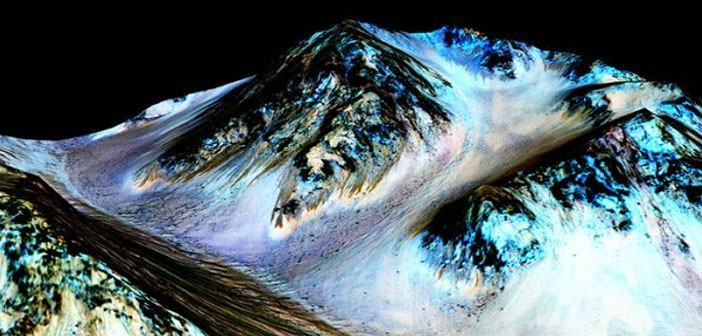Mars water flows in the summer seasons and then disappear in the winter. This was announced by NASA during the afternoon of Tuesday.
About five years ago NASA scientists observed an unusual phenomenon on Mars, especially at certain times of the planet. Specifically, on some steep slopes in the summer Martian developed strange dark spots disappearing in the winter instead. The shape of the spots was typical of a liquid flowing downhill.
At the time, it seemed possible that the hypothetical liquid was water, with the discovery that delivered the first timid proof of his presence on the Martian surface. But because the test would turn into truth, the scientists needed to identify the chemical composition of substances that made up the stains.
Overcome technical obstacles, the scientists were able to verify the offending substances, and Tuesday were able to confirm this: on the surface of Mars flowing saltwater.
Dark waves are called ” recurring slope lineae ” RSL. Appear exclusively on steep slopes, such as the walls of the craters, and follow paths intertwined. Finding favorable climatic conditions are only present in the summer, while in winter and spring is nowhere because of possible freezing due to cold temperatures.
The liquid water should evaporate in the rarefied atmosphere of Mars, the salts dissolved in the liquid inhibit the occurrence of the process by lowering the water freezing point also of 80°C.
It was not easy find confirmation from the first initial tests. The RSL are typically a few meters wide, and the camera used for scans on the planet cannot reproduce the details in the order of one quarter of a meter per pixel. However, the limits further came from the spectrometer (CRISM), which can separate the wavelengths of light and use it to deduce the chemical composition of what is framed. CRISM unfortunately unable to play only 18 meters from the orbit of individual pixels.
The scientists had so implemented a system to understand how to get what they need CRISM. They have thus begun to analyze the areas with a greater influx of RSL, in which the same spots were wider or grouped in a manner such as to fill a single pixel of CRISM with a RSL complete, or almost. Finally, they resumed the same regions even when the RSL disappeared in the same summer.
The results show a clear, consistent with those obtained on all the sites analyzed. In the dark spots are present in all cases hydrated salts: in two of these, there was a mixture of magnesium perchlorate, chlorate, magnesium and magnesium chloride; in another for the most part, sodium perchlorate found in abundance on other sites. Perchlorates have also the characteristic to bind the water and magnesium perchlorate, and are used commercially to remove water from gaseous mixtures.
Even if NASA is not capable of displaying images with the water flowing on Mars, these materials appear only in certain periods of seasonal precise, which means that are transported by a liquid and then precipitate, or that the flows carry with itself a sufficient amount of water such as to change the state of hydration of the salts already present. In all cases, however it involved the presence of water.
The only uncertainty is the source of water, a factor which represents the mystery of the most striking in the whole process of formation of the RSL. The equatorial regions of Mars should have many reservations of ice, which are especially moved toward the poles, as well as water present in the Martian atmosphere should not be enough to trigger the necessary changes for the occurrence of the process.
NASA has promised to investigate the phenomenon and understand what happens in each of these regions of the Martian surface to even respond to this question.

